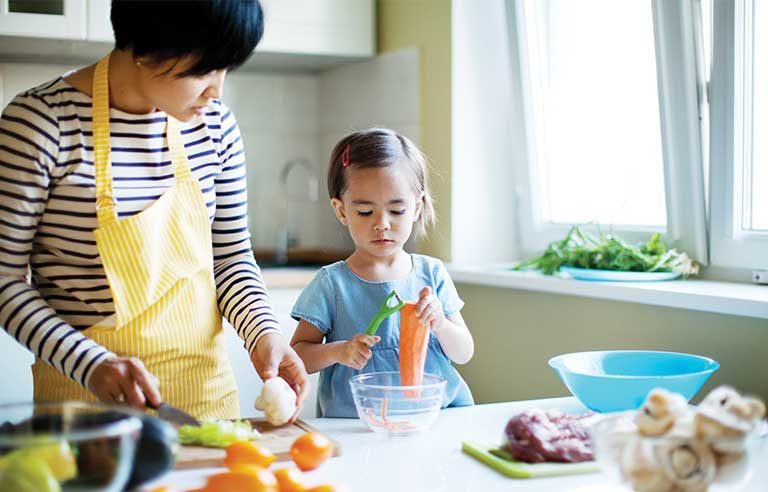The do’s and don’ts of kitchen safety
Get cooking on kitchen safety by following these do’s and don’ts.

Whether it’s out of necessity, an opportunity to eat healthier or a newfound hobby, you need to be aware that “there are a lot of things in the kitchen you don’t think about that could cause you harm,” said Betty Brennan, chair of the Emergency Nurses Association’s Quality and Safety Advisory Council. “You have to think it through and ask, ‘Is my action safe for me and my family?’”
Get cooking on kitchen safety by following these do’s and don’ts.
A clean kitchen is a happy kitchen
DO wash your hands: David Tiner, chef and director of the Louisiana Culinary Institute, teaches this lesson early to future professionals. It’s just as important for people cooking at home.
“The one thing we really preach is proper handwashing,” he said. “That’s where most foodborne illnesses are going to happen.”
Using soap and water for 20 seconds, the Centers for Disease Control and Prevention says, can effectively stop the spread of germs.
DON’T work in a cluttered kitchen: “Things can fall off (the counter) or you can cut yourself on a knife you didn’t see,” Brennan said. Clutter also can lead to a towel or an oven mitt being left on the stovetop, where it can catch on fire.
Say no to Salmonella
DO understand how foods can be contaminated: For example, if you touch your nose while cutting a chicken breast, any bacteria on your nose is now on the food and will be served to your family.
“If people eat it, it looks fine and it tastes fine, until 30 minutes to 24 hours later,” Tiner said. “Then they’re sick.”
He also says you should keep an eye on raw meats in your refrigerator to make sure liquid from them doesn’t spill onto other foods. When it’s time to cook, prepare raw meats first, then wash any utensils and cutting boards you use. Sanitize food prep areas before preparing vegetables, and use different cutting boards for meats and vegetables.
DON’T use a kitchen towel for all cleaning tasks: Wiping your hands, then a stove, counter, cutting board, etc., with one cloth towel will merely spread germs.
A cut above the rest
DO keep knives sharp: “A dull knife is actually more dangerous than a sharp knife,” Tiner said. “With a dull knife, you have to apply more pressure to cut.”
This added pressure can make it easier for a dull knife to slip from your grip, especially when you’re cutting a hard food such as a carrot. When a dull knife slips, Tiner said, it’s more likely to cause a tearing injury when it hits your hand.
When using a sharp knife, Tiner said your best grip is to pinch the top of the blade in front of the handle with your thumb and forefinger. Then, wrap your other fingers around the handle.
“That gives you more stability and control than just grabbing it by the handle,” he said.
Form your non-cutting hand into a “tiger paw,” with fingertips tucked toward your palm to protect yourself from cutting injuries. This will help apply pressure to the object you’re cutting.
DON’T leave knives in the open: Store your knives in a wooden block or in their own drawer, out of the reach of children, Brennan said. This will prevent knives from falling or being grabbed improperly from a magnetic strip.
Feel the burn?
DO know when to seek treatment: If you burn yourself while cooking, emergency care is necessary if the burn is larger than the palm of your hand, Brennan said. The same goes if the pain is persistent or blisters form on your skin.
DON’T use old oven mitts or pot holders: When these items show signs of wear, throw them away. Frayed or thinning material can cause burn injuries.
Too many cooks in the kitchen?
DO make your kids ask for permission to help: Make it a rule that kids have to receive permission before helping you cook, Brennan said. This gives you the opportunity to reinforce safety lessons.
DON’T let kids get too close: Holding a child in your arms or sitting him or her on a countertop while you cook is a no-no. Instead, Brennan said, establish a 3-foot “safe zone” around stoves.
Don’t feed the fire
DO know how to extinguish a small fire: Cooking on the stovetop? Keep your pot/pan lid or a baking sheet nearby, said Teresa Neal, a fire program specialist at the U.S. Fire Administration. That way, if a fire starts, you can put the lid or baking sheet on top of the pot/pan and turn off the burner, extinguishing the fire.
If something catches fire in your oven, immediately turn off the oven and keep the door closed. “Opening that door will just feed oxygen to the fire,” Neal said. Instead, keep a close eye on the fire and let it burn itself out.
For microwave fires, press the “cancel” button to stop the cooking and, if possible, unplug the appliance.
DON’T try to extinguish a large fire: In 2018, cooking was the leading cause of all residential fires (192,700), leading to 3,100 injuries and 170 deaths, according to the USFA.
If a kitchen fire spreads to cabinets or other surfaces, Neal recommends evacuating everyone from the home and calling 911.
Post a comment to this article
Safety+Health welcomes comments that promote respectful dialogue. Please stay on topic. Comments that contain personal attacks, profanity or abusive language – or those aggressively promoting products or services – will be removed. We reserve the right to determine which comments violate our comment policy. (Anonymous comments are welcome; merely skip the “name” field in the comment box. An email address is required but will not be included with your comment.)
